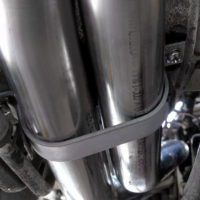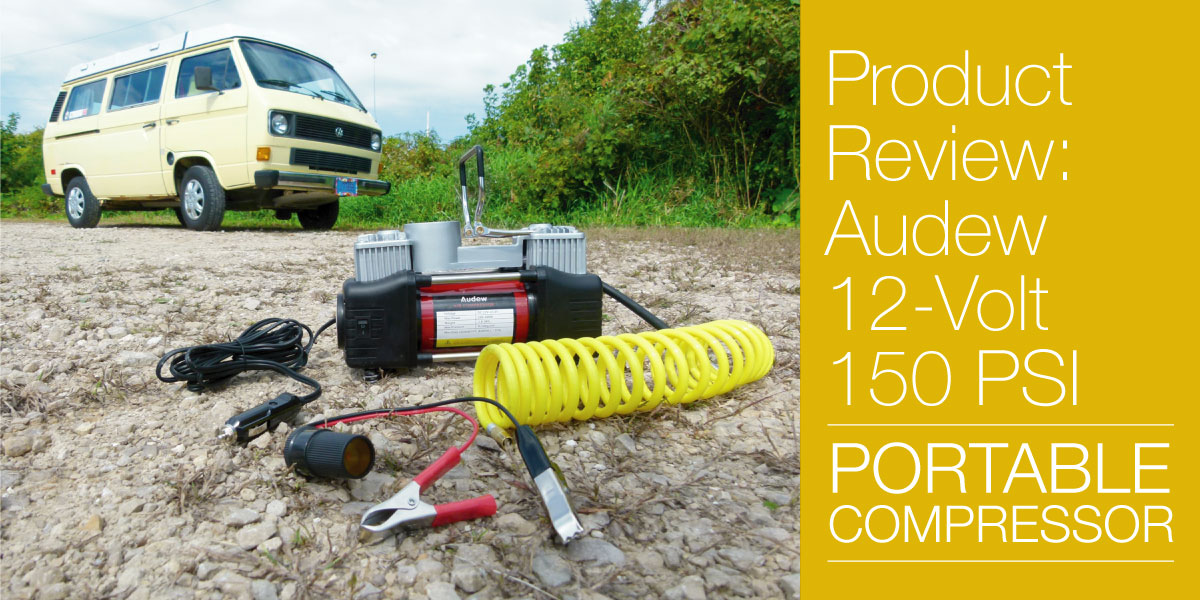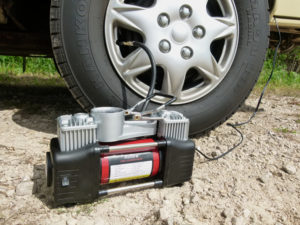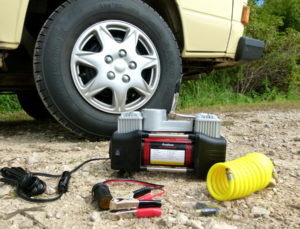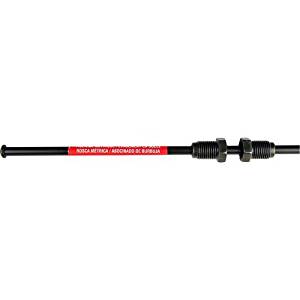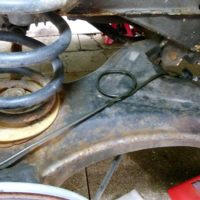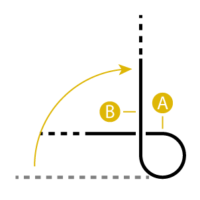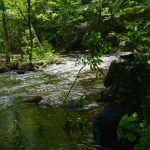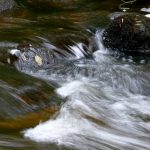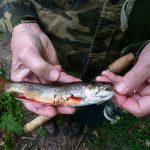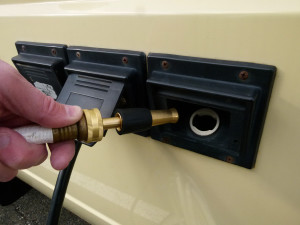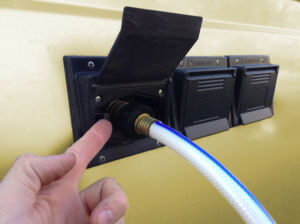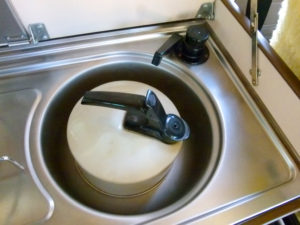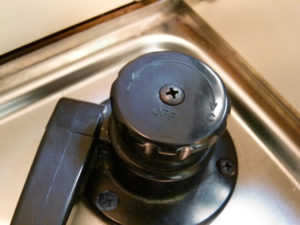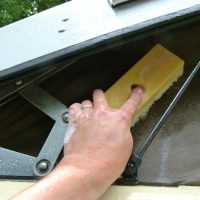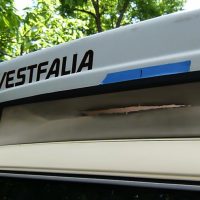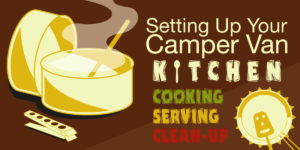If the galley kitchenette is part of what makes a Westfalia a cozy Camper, then the onboard liquid propane system is the power source of that kitchen.
It provides an exceptionally efficient, affordable, easy, and clean means to run both the refrigerator and the stove.
Let’s have a look at the Westfalia propane system to familiarize ourselves with the various components, and how to use ’em!
Introduction
The Vanagon Westfalia external LP (Liquid Propane) tank is mounted on the underside of the van, on the left-hand side, and is plainly visible below the Camper hookups. The valves and regulator are protected by a steel shield, and new Campmobiles were delivered with a heavy-duty mudflap behind the left-front wheel to prevent stone damage.
The heavy steel tank is rated for 3 gallons of LP (liquid propane), but is filled to only 80% capacity, to allow room for safe expansion:
- 2.4 gallons
- 9.6 lbs.
- 9.6 liters
Overview
Starting at the rear end of the tank and moving forward, you’ll see the main components:
Overflow Bleeder Valve
The propane technician will open this bleeder while filling your tank to release excess propane vapors, and as an indication as to when the tank has reached its capacity of 80%.
Fill Valve
Under a protective plastic cap is the heavy brass fill port fitting. This is where the technician will connect his filler hose valve to pump pressurized propane into your tank.
Main Control Valve
This primary valve is what turns On or Off the supply of propane from your tank. As with most such valves, turn it clockwise to turn the propane supply Off; turn it completely counter-clockwise to turn the propane On.
Two-Stage Regulator
Opening the Main Control Valve allows high-pressure propane to enter the first stage of the regulator, which reduces the pressure to about 15 PSI. A secondary stage further reduces the line pressure to about 0.5 PSI for use by the kitchen appliances. The regulator is often covered by a protective plastic housing to keep it clean of mud, etc..
Tee Fitting
Immediately to the left of the regulator the line divides into two supply lines, which pass upward through the floor of the van to provide propane to the kitchen; the upper copper line supplies the refrigerator, while the lower line provides gas to the stove.

Filling
The Westfalia LP tank accepts a standard fill nozzle found at most commercial propane dealers, such as RV service centers, U-Haul outlets, many hardware stores, and some campgrounds. Unfortunately, many younger or inexperienced LP technicians may be unfamiliar with the Westy’s older design. So, if you find a place that you like, continue going there for your propane refills.
Compared to most other RVs, the Westfalia’s LP fill port is mounted quite low to the ground, and is relatively difficult to access. You can make things easier for your propane guy by parking near the LP station, laying out a padded foam kneeling pad or carpet scrap, and removing the plastic cap from your fill valve. Make sure the main control valve is OFF before filling. I also like to ensure that the overflow bleeder valve is working freely by briefly loosening & tightening it beforehand, so the tech doesn’t need to twist on it with a pair of old pliers. Wear a heavy glove when doing this, to avoid severe cold-burns from escaping liquid propane.
At only 3 gallons, the Westy’s tank is barely half the capacity of a typical BBQ propane tank, and is likely one of the smallest tanks many techs will encounter. So, it tends to reach capacity sooner than expected unless completely empty, and results in only an eight-dollar sale.
Let the tech do his thing, and consider tipping him for his troubles. Replace the filler valve cap, and make sure the overflow bleeder valve is fully closed (an LP tech once left mine somewhat loose, resulting in a slow but dangerous LP leak).
Driving
Though legal to drive while using the propane to power the fridge, save the LP and switch the fridge to 12 VDC while underway.
Liquid Propane Consumption
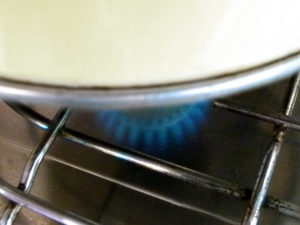 Though the tank is small, both the stove and the fridge are quite efficient, so a refill lasts a good long while. In normal usage, even running the fridge 24/7 and cooking 1-2 hot meals each day, a single tankful will last an entire month.
Though the tank is small, both the stove and the fridge are quite efficient, so a refill lasts a good long while. In normal usage, even running the fridge 24/7 and cooking 1-2 hot meals each day, a single tankful will last an entire month.
The Westfalia propane tank has no gauge to tell you how much LP is left, so after a refill, start a simple log book to keep track of your typical camping days, so you have some idea of how much fuel you can expect from a tankful.
Maintenance
The LP system requires virtually no periodic maintenance, other than routine washing of the tank exterior, valves, and regulator. Periodically inspect these parts, the tank body, and the supply lines for dents, scrapes, or other damage. If you ever smell the distinctive odor of liquid propane, immediately make sure the main control valve is closed. You can also spray soapy water on any of these components; if the soap mixture forms bubbles, there is a leak.
If ever in doubt, see a qualified RV propane service center for repair or replacement of your tank or other components.
Finally …
As the main fuel source for the stove and refrigerator, the liquid propane system is a key player in the Westfalia Campmobile, and provides easy, economical, and reliable convenience.








